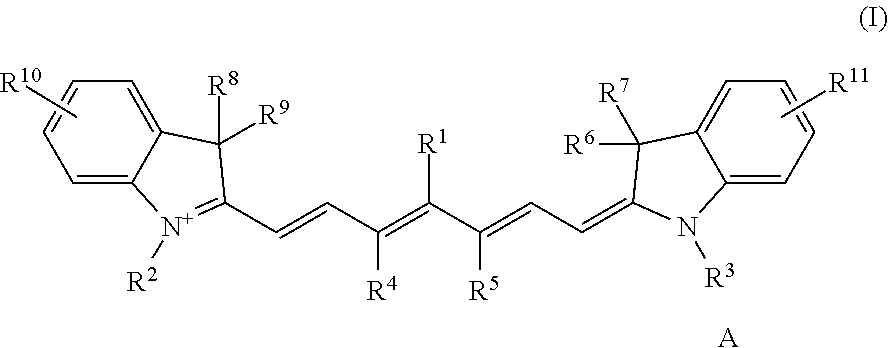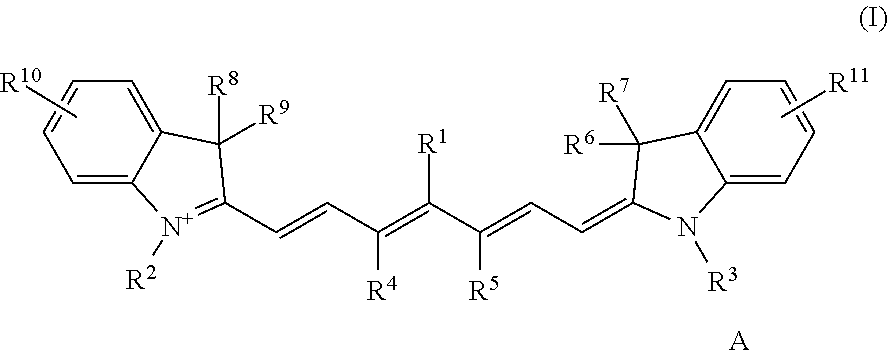Negative-working lithographic printing plate precursors with IR dyes
a technology of lithographic printing plate and precursor, which is applied in the field of negative-working lithographic printing plate precursor, can solve the problems of reducing the shelf life of imageable layer composition, cationic cyanine dye, and precursors with a strong tendency to crystallize, and achieve excellent imaging speed and the tendency of crystallization of cationic cyanine dy
- Summary
- Abstract
- Description
- Claims
- Application Information
AI Technical Summary
Benefits of technology
Problems solved by technology
Method used
Image
Examples
embodiment 1
[0164]2. The lithographic printing plate precursor of embodiment 1 wherein L is a sulfur or nitrogen linking atom, and Rx represents a carbocyclic or heterocyclic aromatic group, a heterocyclic non-aromatic group, or an alkyl group having 1 to 12 carbon atoms, which carbocyclic or heterocyclic aromatic, heterocyclic non-aromatic, or alkyl group comprises one or more ethylenically unsaturated polymerizable groups.
[0165]3. The lithographic printing plate precursor of embodiment 1 or 2 wherein L is a single connecting bond, and Rx is a group represented by the following Structure (II) wherein Y is oxygen or sulfur, and Ry and Rz are the same or different organic groups as described for Rx, at least one of which comprises one or more ethylenically unsaturated polymerizable groups:
[0166]
[0167]4. The lithographic printing plate precursor of any of embodiments 1 to 3 wherein Rx comprises a mercapto-functionalized thiazole or thiadiazole group and one or more ethylenically unsaturated polym...
embodiment 15
[0181]16. The method of embodiment 15 comprising processing the imaged precursor off-press using a processing solution.
[0182]17. The method of embodiment 15 comprising processing the imaged precursor on-press using a lithographic printing ink, a fountain solution, or both a lithographic printing ink and a fountain ink.
[0183]19. The method of any of embodiments 15 to 18 comprising imagewise exposing the lithographic printing plate precursor using radiation having a λmax of at least 700 nm and up to and including 1400 nm.
[0184]The following Examples are provided to illustrate the practice of this invention and are not meant to be limiting in any manner. The components and materials used in the examples were as follows:
[0185]BLO represents γ-butyrolactone.
[0186]Byk® 307 is a polyethoxylated dimethyl polysiloxane that is available from Byk Chemie.
[0187]CD9053 is an adhesion promoter that is available from Sartomer.
[0188]Developing Solution A contained 7.14 g of phenoxy ethanol, 1.71 g o...
PUM
| Property | Measurement | Unit |
|---|---|---|
| weight % | aaaaa | aaaaa |
| thickness | aaaaa | aaaaa |
| thickness | aaaaa | aaaaa |
Abstract
Description
Claims
Application Information
 Login to View More
Login to View More - R&D
- Intellectual Property
- Life Sciences
- Materials
- Tech Scout
- Unparalleled Data Quality
- Higher Quality Content
- 60% Fewer Hallucinations
Browse by: Latest US Patents, China's latest patents, Technical Efficacy Thesaurus, Application Domain, Technology Topic, Popular Technical Reports.
© 2025 PatSnap. All rights reserved.Legal|Privacy policy|Modern Slavery Act Transparency Statement|Sitemap|About US| Contact US: help@patsnap.com



